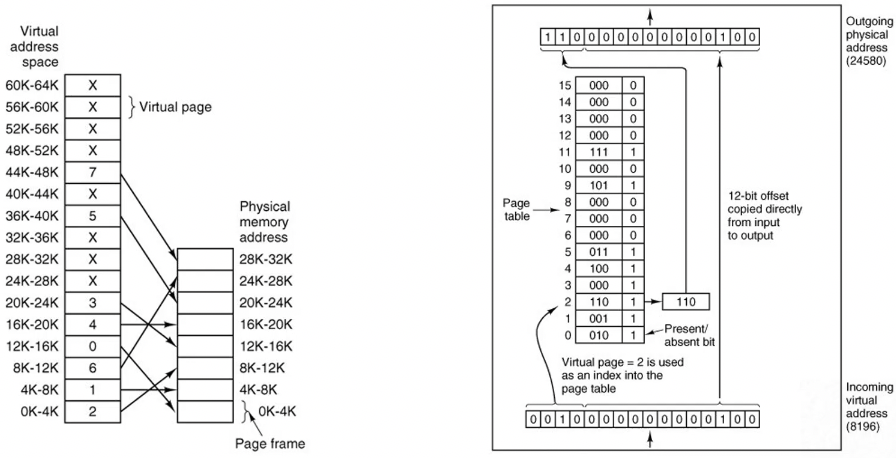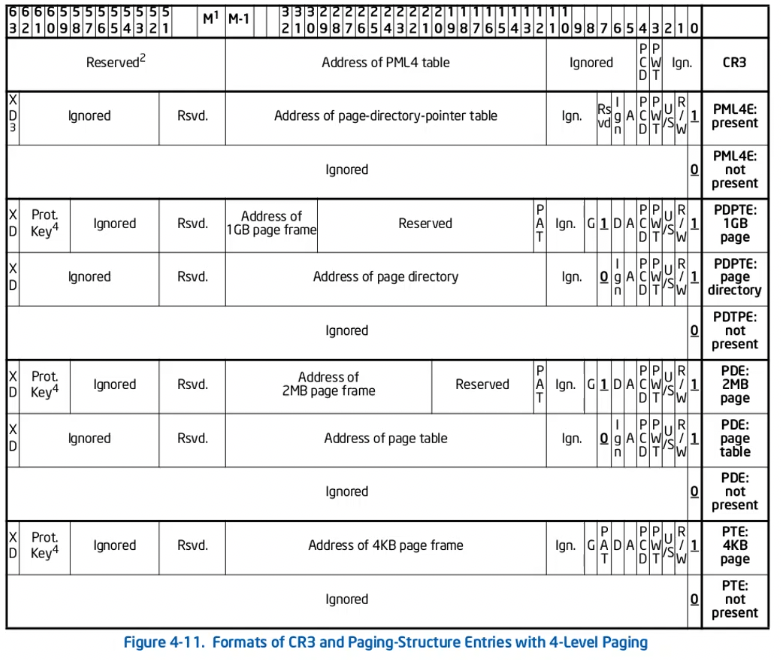Advanced OS
Table of Contents
Page tables
Memory access
What happens on pointer dereference? It depends. Address in virtual memory may not be the same as in RAM.
Virtual memory:
- OS tells CPU how to map virtual memory addresses to physical memory addresses
- OS creates page table: storing physical addresses, indexed with virtual addresses
- physical address of page table are in special register (car3)
- on memory access, CPU looks up virtual address to find physical address
Address spaces
- OS can create multiple page tables
- each defining different virt → phys mapping
- only one active at a time, selected by cr3
- each page table defines address space
Why address spaces?
- virtualize physical memory
- flexible memory management
- isolation and protection
Page tables
address translated at page granularity
- page: chunk of memory
- architecture defines possible page size(s), typically 4 KB
Memory Management Unit (MMU) performs translation
Basic linear page-table
Let’s say we dereference virtual address 0010000000000100.
- The first 4 bits are index into page table.
0010is 2 in decimal, so page at index 2 in page table is used. - Index 2 contains the value
1101, where the last bit is the ‘present/absent’ bit (i.e. does the entry map to a physical address). The first 3 bits are used as the first 3 bits in the outgoing physical address. - The resultant physical address is
110000000000100: the 3 bits from the page table entry, and the 12 bits copied from the virtual address.

Hierarchical page tables (x86_32)
Use a top-level page table that points to other page tables.
The first 10 bits are an index into top-level page table, the second 10 bits index into second-level page table, and the last 12 bits are the offset.
The downside is, you need more lookups.
Inverted page tables (IA64)
Make a page table tailored to the size of physical memory instead of virtual. Then, use a hash table, indexed by hash on virtual page, with list of pages.
Four-level page tables (x86_64)
Only implements lowest 48 bits of the address, the rest are sign extend.
Register cr3 is pointer to a highest-level page table (PML4E). First 9 bits are index into table, which points to page-directory-pointer table (PDPE). The next 9 bits to page-directory table, then the page table, then a physical page, with the last 12 bits being the offset.

Page table management
Static page tables for bootstrapping
OpenLSD maps two locations in virtual memory:
- identity, i.e. address is same as in virtual and physical
- KERNBASE (where kernel is loaded)
- programs are loaded at lower address after
In AT&T syntax (src, dst):
movl $(PAGE_PRESENT | PAGE_WRITE | PAGE_HUGE), %eax ; mapping 2 MiB pages
movl $page_dir, %edi
movl $4, %ecx ; we want 4 entries
.map_pages: ; identity mapping
movl %eax, (%edi)
addl $0x200000, %eax ; map next physical address
addl $8, %edi
dec %ecx ; decrement counter
jnz .map_pages
;; at next higher level, load single entry with identity mapping
movl $page_dir, %eax
orl $(PAGE_PRESENT | PAGE_WRITE), %eax
movl %eax, pdpt
;; and higher level again
movl $pdpt, %eax
orl $(PAGE_PRESENT | PAGE_WRITE), %eax
movl %eax, pml4
movl %eax, pml4 + 256*8
;; Load the root into cr3
movl $pml4, %eax
movl %eax, %cr3

Dynamic page table management (post boot)
Two issues:
- what should your virtual address spaces look like (policies)
- how would you do these things (mechanisms)
Policies:
- Supervisor bit: allow or disallow kernel access
- Present bit: 1 if the page is mapped (but should also clear page frame address on unmap).
- page table address bits: point to physical address (need to flush CPU buffers containing recent data to avoid RIDL)
Mechanisms:
- dynamically update page tables per address space
- MMU uses updated page tables to find physical pages for virtual pages
page table walk on x86_64 with 4-level page table, 48 bit virtual address, page tables mapped in virt memory:
- locate top-level page table: read cr3 register (or process struct)
- locate 2nd-level page table
- get virtual pointer to top-level page
- use bits 39-47 of virtual address as index
- if not page table entry present, abort.
- locate 3rd-level page table
- get virtual pointer to 2nd-level page
- use bits 30-38 of virtual address as index
- if not page table entry present, abort.
- …
- last page table entry has physical address of page
page table mapping:
- locate page table entry for virtual address to be mapped, using page walk
- if not present: allocate new page, store physical address in non-present entry, continue with next level
- store physical address to be mapped in final page table entry & mark as present
page table unmapping
- locate page table entry for virtual address to be unmapped, using page walk
- zero out final page table entry
- free pages
permission bits:
- P: present (1) or not (0)
- R/W: read-only (0) or writable (1)
- U/S: supervisor-only (0, i.e. kernel) or user-accessible (1)
- SMAP protection: 1 becomes user-only
- XD: execute allowed (0) or disabled (1)
Optimizations
TLB (caching)
result of page table translation: virtual address x is at physical address y
approach for memory access:
- look up x in TLB
- on hit, no need to consult page table
- on miss, page table walk and then cache in TLB
Needs to be super fast, so small number of sets.
Flush TLB:
- when switching to new address space
- when deleting/updating page table entries
TLB scalability:
- translation caches:
- TLB tagged with all bits of virtual address
- translation caches tagged with part of virtual address
- managed transparently by hardware
- use bigger pages
Security
- leave holes in identity map (i.e. guard pages)
- no wastage, but more complex management
- kernel exploitation:
- find known locations in kernel space: physmap (mapping of physical address space), kernel base address
- trigger vulnerability and corrupt data in known locations, or diverge control flow
kernel address space layout randomization (KASLR):
- randomizes sections of kernel address space
- harder to exploit the kernel. but still, bruteforce (though crashes), or leak kernel pointers (need second vulnerability), or side-channel attacks (but complicated)
- implementation:
- limit entropy to simplify memory management
- remain same until reboot
- random slot chosen early in boot, kernel mapped there
- random mapping translates to different slots in page table pages